The Challenge of Central Banking in a Democratic Society
Remarks by Chairman Alan Greenspan
At the Annual Dinner and Francis Boyer Lecture of The American Enterprise Institute for Public Policy Research, Washington, D.C.
December 5, 1996No matter how complex individual products become, there will always be some general sense of the purchasing power of money both across time and across goods and services. Hence, we must assume that embodied in all products is some unit of output and hence of price that is recognizable to producers and consumers and upon which they will base their decisions. Doubtless, we will develop new techniques of price measurement to unearth them as the years go on. It is crucial that we do, for inflation can destabilize an economy even if faulty price indexes fail to reveal it…
Clearly, sustained low inflation implies less uncertainty about the future, and lower risk premiums imply higher prices of stocks and other earning assets. We can see that in the inverse relationship exhibited by price/earnings ratios and the rate of inflation in the past. But how do we know when irrational exuberance has unduly escalated asset values, which then become subject to unexpected and prolonged contractions, which then become subject to unexpected and prolonged contractions as they have in Japan over the past decade? And how do we factor that assessment into monetary policy?
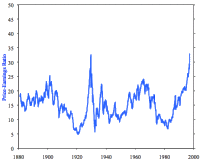 In a previous post [tales from the treasury: the gift of the Magus [declined]…], I described Dr. Robert Shiller‘s warning to the Federal Reserve that the Stock Market was becoming dangerously inflated using his 10 year P/E ratio chart [shown on the right up to the time of that presentation]. That warning was 3 days before Greenspan’s speech, and was obviously a stimulus for Greenspan’s irrational exuberance comment.
In a previous post [tales from the treasury: the gift of the Magus [declined]…], I described Dr. Robert Shiller‘s warning to the Federal Reserve that the Stock Market was becoming dangerously inflated using his 10 year P/E ratio chart [shown on the right up to the time of that presentation]. That warning was 3 days before Greenspan’s speech, and was obviously a stimulus for Greenspan’s irrational exuberance comment. But I hadn’t noticed the earlier paragraph quoted above. He’s talking about how we measure Inflation [and Deflation]. Economists generally use the Consumer Price Index in various forms [with energy and food removed, it’s called "core inflation"]. Again Shiller must have made an impression on Chairman Greenspan with his chart, because Greenspan is talking about "new techniques" to measure Inflation. He’d actually been shown one just three days before. Here is Shiller’s 10 year P/E ratio through 2000 [shown with the Fed’s Long Term Interest Rates]:
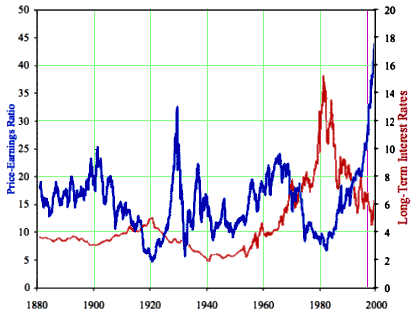
It played out just as Dr. Shiller predicted it would. Shortly after the end of this graph, the dot.com bubble burst in spades! [the purple line is the approximate time of Greenspan’s speech]. Here’s Shiller’s data compared to the Federal Fund Interest Rate [the one the Fed adjusts]:
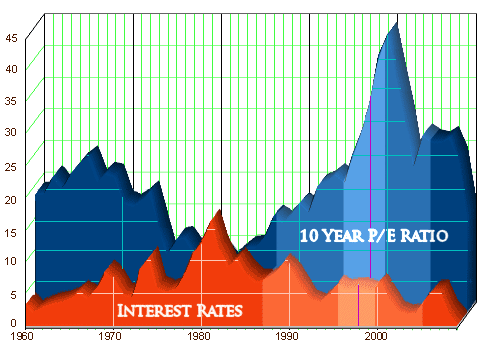
It shows that in spite of his speech about irrational exuberance, and in spite of knowing that conventional measures of Inflation were inadequate, Greenspan kept Interest Rates low. Yet Shiller’s data clearly indicated that the Stock Market was behaving irrationally [to say the least]. Note that Shiller’s 10 year P/E ratio measured the Stock Market in general, not just the technology sector. The whole market was inflated!
The mortgage market and consumer debt
Remarks by Chairman Alan Greenspan
At America’s Community Bankers Annual Convention, Washington, D.C.
October 19, 2004About three-fourths of all outstanding first-lien mortgages were originated with a loan-to-value ratio of 80 percent or less, and in aggregate, the current loan-to-value ratio is estimated to be around 45 percent. Even though some down payments are borrowed, it would take a large, and historically most unusual, fall in home prices to wipe out a significant part of home equity. Many of those who purchased their residence more than a year ago have equity buffers in their homes adequate to withstand any price decline other than a very deep one.
Housing price bubbles presuppose an ability of market participants to trade properties as they speculate about the future. But upon sale of a house, homeowners must move and live elsewhere. This necessity, as well as large transaction costs, are significant impediments to speculative trading and an important restraint on the development of price bubbles. Some homeowners drawn by large capital gains do sell and rent. And certainly in recent years some homebuyers fearful of losing a purchase have bid through sellers’ offering prices. But these market participants have probably contributed only modestly to overall house price speculation.
More likely participants in speculative trading are investors in single residence rental and second home properties. But even though in recent years their share of purchases of single family homes has been growing, in 2003 their mortgage originations were still less than 11 percent of total home mortgage originations. Overall, while local economies may experience significant speculative price imbalances, a national severe price distortion seems most unlikely in the United States, given its size and diversity…
While I hold my point that the reason Greenspan kept the Interest Rates low from 1995 to 2000 was to stimulate the economy after the Savings and Loan Crisis [the Why of Alan Greenspan’s destruction of our economy…], I have to admit that part of the problem was that he and the majority of the rest of us were clueless about the importance of Financial Bubbles [localized inflation of some Asset].
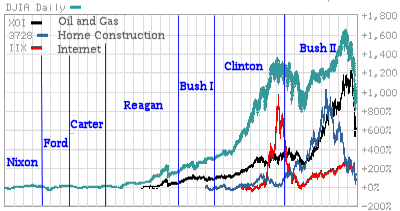
But here’s the punch line of this post:
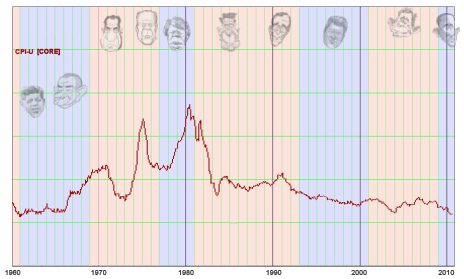
Sorry, the comment form is closed at this time.